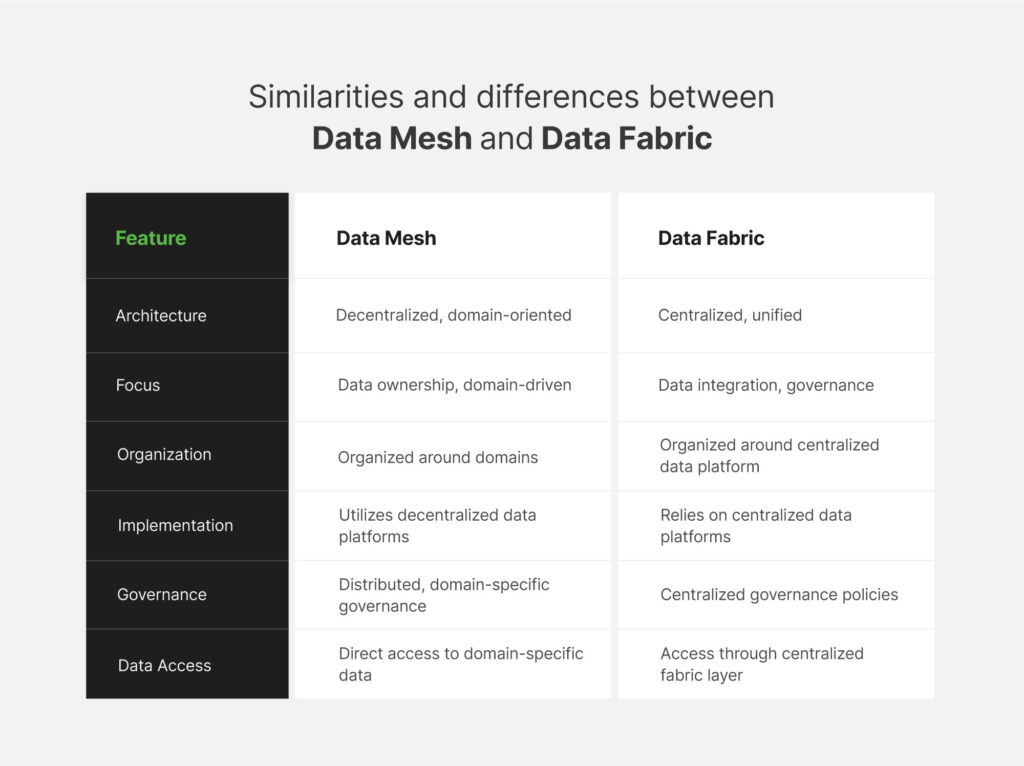
Data & AI Evangelist

Principal Data Architect
Subscribe to the newsletter
Data management is a challenge for organizations worldwide as they grapple with growing volume, variety and complexity of data. While businesses emphasize autonomy and productivity, they are still stuck with siloed data and monolithic architecture that leaves them drowning in a data lake and struggling to extract valuable insights. A survey showed that approximately 50-70% of data generated and stored by organizations remains unused, transforming into what Gartner calls “dark data.”
To address the dynamic requirements of modern businesses and effectively manage data across complex and distributed environments, organizations often turn to two prominent data architecture approaches i.e., Data Fabric and Data Mesh. These innovative data management approaches serve as a promising solution to break down silos and facilitate the extraction of actionable insights from the vast trove of data.
But the question remains: Which approach is better for your organization to make informed decisions and manage data at scale? This blog explains both Data Mesh and Data Fabric while highlighting the differences and benefits of each approach to help you determine which fits your organization’s needs.
What is a Data Fabric?
Gartner defines Data Fabric as,
“A design concept that serves as an integrated layer (fabric) of data and connecting processes.”
Data Fabric architecture is a centralized data management, governance, and processing approach. This approach supports end-to-end integration of diverse data sources through cutting-edge AI/ML technologies. Data fabric solutions aim to create a unified data layer across the entire organization for easy access and processing to ensure quality, consistency, and security.
The most important thing about Data Fabric is its architecture and the array of data services it encompasses. Data fabric ensures a smooth exchange of information across various platforms, whether storing data on-premises, in the cloud, or in a hybrid environment. This flexibility ensures that data, regardless of its format or location, stays integrated and readily accessible.
Gartner reports that Data fabric reduces integration design time by 30%, deployment time by 30%, and maintenance time by 70%. While it’s clear that using Data Fabric boosts productivity, empowering both businesses to make rapid decisions and focused expertise utilization.
However, the main characteristic of this centralized approach includes:
- Centralized governance
- Data visualization
- Unified view
- Integration-centric
- Data protection
What is Data Mesh?
Zhamak Dehghani, a principal consultant at Thoughtworks, introduced Data Mesh in her 2019 article titled “How to Move Beyond a Monolithic Data Lake to a Distributed Data Mesh,” followed by the December 2020 report titled “Data Mesh Principles and Logical Architecture.”
Furthermore, Zhamak Dehghani promotes data mesh to address challenges posed by centralized, monolithic data structures, like accessibility and organization.
IBM defines Data Mesh as,
“Decentralized data architecture that organizes data by a specific business domain—for example, marketing, sales, customer service, and more—providing more ownership to the users.“
Instead of centralized, monolithic, and traditional storage systems like data warehouses or lakes, Data Mesh promotes domain-oriented and self-service infrastructure. This means individual teams or departments can access multiple decentralized data repositories.
The reason that many businesses embrace Data Mesh is because it provides improved access control and governance, reducing bottlenecks. The Date Mesh architecture is built upon four principles:
- Domain-oriented ownership
- Data as a product
- Self-service data infrastructure
- Federated computational ecosystem
Are both Data Mesh and Data Fabric the same?
While both Data Mesh and Data Fabric address challenges associated with data management and siloed data, these approaches differ in various aspects. Let’s take a look at three major differences.
Design principle
Data Mesh is a decentralized approach where the data is organized by its individual domain to make it accessible and discoverable across the entire organization.
Data Fabric is a centralized approach that uses data from various data sources (structured and unstructured) to provide users with a single source of access.
Architecture
Data Mesh architecture allows more flexible data integration and interoperability functionality to allow organizations to adapt and evolve their data ecosystems.
Data Fabric architecture is a more automated (technology-focused) approach than Data Mesh, relying less on manual efforts for data integration, access, and governance tasks.
Data governance
In a Data Mesh governance model, data governance is distributed across different organizational domains, each responsible for its own data quality and standards.
Within Data Fabric architecture, data governance provides a centralized governance framework that makes it easier for organizations to implement data governance policies.
In a nutshell,
Data Fabric and Data Mesh offer data access architecture. Data Fabric emphasizes technology and Data Mesh centering on organizational change. Data Mesh prioritizes people and processes over architecture. While Data Fabric intelligently handles data and metadata complexity, complementing each other effectively.
Similarities and differences between Data Mesh and Data Fabric
While both Data Mesh and Data Fabric aim to address the complexities of managing data within an organization, both concepts diverge in their underlying principles and organizational strategies. Take a look at the table outlining the similarities and differences between these two distinct architectural approaches.

Data Mesh vs Data Fabric: Which to choose or ditch?
As data multiplies, businesses need data management to overcome the threats posed by the vast amount of daily data. The right choice depends heavily on whether an organization needs a unified or decentralized approach. Your business could rely on either both or one at a time. In a nutshell, the choice depends on the level of data maturity, business benefits, and budget.
Bottomline
There’s no denying that data fabrics and data meshes will remain equally relevant for the foreseeable future. While both differ in their approach, they both share the same goal of bringing greater analytics to an organization.
Considering the challenges in adopting data mesh and data fabric, Confiz helps businesses navigate the adoption of either approach. Confiz with its expertise in data management, analytics, and technological innovation, guides organizations in implementing these approaches effectively.
So, contact us at marketing@confiz.com and let our experts help you skyrocket your business’s data management.



